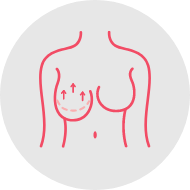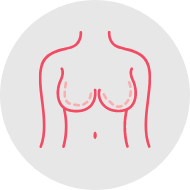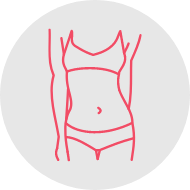Breast Asymmetry
Procedures
Understanding Breast Asymmetry
Breast asymmetry refers to differences in size, shape, volume, or position between each breast. These variations are common and can range from subtle to more noticeable.
Changes in breast size and shape may also occur with hormonal fluctuations during life stages such as menstruation, ovulation, and pregnancy. In cases where asymmetry is more noticeable, patients may seek treatment to address concerns related to appearance or physical comfort.
Dr Magnusson will discuss options that may be suitable for you during a consultation following an individual assessment.
Treatment Outcomes

May address differences in size, shape, or position between the breasts

May involve adjustments to breast volume or tissue distribution

May include changes to nipple position or appearance

Repositioning of breast tissue may be performed to support overall structure
Allure
Breast Asymmetry Before and After Gallery – Patient Results
Disclaimer: The outcomes shown are only relevant for these patients and do not necessarily reflect the results other patients may experience, as results may vary due to many factors including the individual’s genetics, diet and exercise.



FREQUENTLY ASKED QUESTIONS
What can cause breast asymmetry?
Breast asymmetry can result from factors such as hormonal changes, weight fluctuations, genetics, or medical treatments like breast cancer surgery. Injury to the chest wall or certain medical conditions may also contribute to this condition. Developmental differences in the breasts – tuberous breast deformity can also cause asymmetry.
At what age can corrective surgery be considered?
Breast development can happen at different rates during adolescence, and it may become more even over time. Surgery is usually delayed until development has finished, unless the difference is clearly visible or associated with physical discomfort.
What are the treatment options for breast asymmetry?
Treatment plans are developed based on individual anatomy and goals. Options may include increasing the size of a smaller breast, reducing or lifting a larger breast, or performing adjustments to both breasts. These procedures can involve implants, autologous fat grafting, tissue reduction, or a combination of approaches to modify breast size or shape.
What should I know about outcomes and longevity?
Surgery may address asymmetry, but natural changes in the breasts can continue over time due to ageing, weight changes, or gravity. Implants, if used, may require replacement in the future. Treatment results vary between patients and are discussed during a consultation.
Will my health fund or Medicare assist with costs?
If the procedure is considered reconstructive due to significant asymmetry, Medicare and private health insurance may contribute to costs. This can include theatre fees, accommodation, and some medical professional costs. Patients are encouraged to check their individual health fund policy to confirm coverage and understand any out-of-pocket expenses.
What are the possible risks and complications of breast asymmetry correction surgery?
As with any surgical procedure, there are risks. These may include:
- Bleeding
- Infection
- Delayed wound healing
- Changes in nipple or skin sensation
- Visible scarring
- Asymmetry
- And the potential need for further surgery.
Risks are discussed in detail during the consultation, and a full medical history is reviewed to support appropriate planning.

